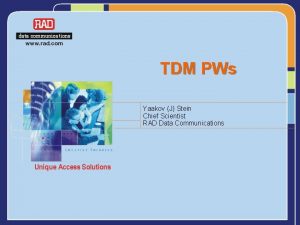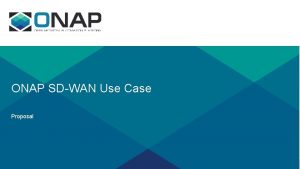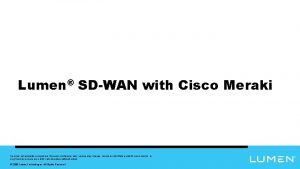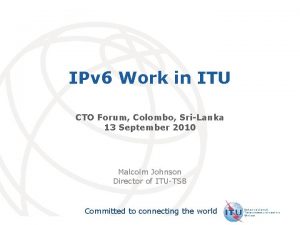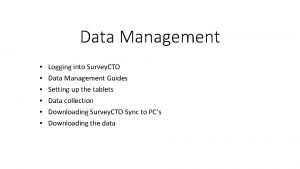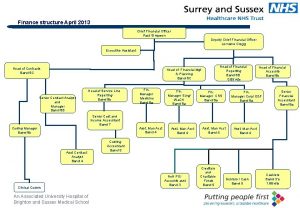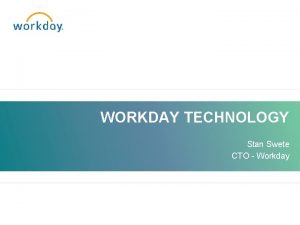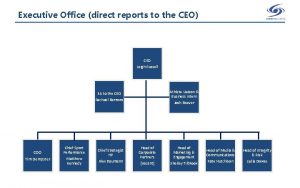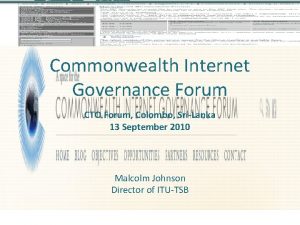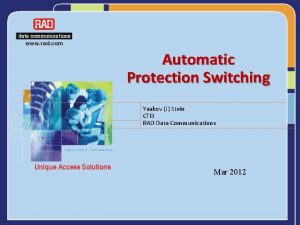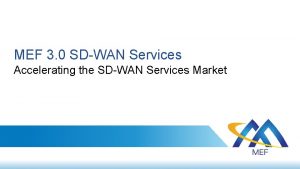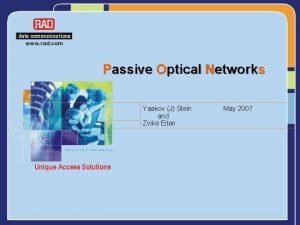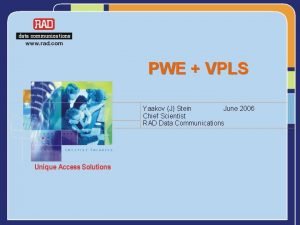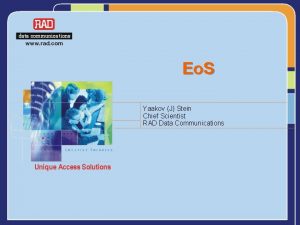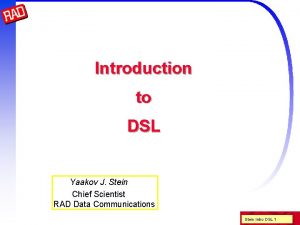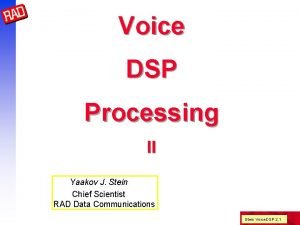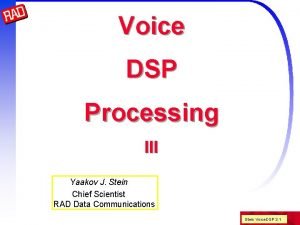SDWAN Yaakov J Stein CTO SDWAN 1 The









































- Slides: 41

SD-WAN Yaakov (J) Stein CTO SD-WAN 1

The need for SD-WAN 2

Why do we pay for services ? Generally good (and frequently much better than toll quality) voice service is available free of charge (e. g. , Skype) So why does anyone pay for voice services ? Similarly, one can get free • (Wi. Fi) Internet access • email boxes • search services • file storage and sharing • web hosting • software services So why pay for any service ? SD-WAN 3

Paying for Qo. S The simple answer is that one rarely pays for Best Effort service one pays for Quality of Service guarantees For example, for voice communications services price toll quality with mobility BE Qo. S Of course, one really would like to pay for Quality of Experience but that may be hard to measure Qo. S parameters proxy for Qo. E SD-WAN 4

Service Level Agreements In order to justify recurring payments service providers agrees to a minimum level of service in a Service Level Agreement (SLA) An SLA is a legal commitment between a service provider (SP) and a customer, for example: • Telco and subscriber • ISP and Internet user • VPN operator and enterprise • cloud application provider and cloud user SLAs typically include (financial) penalties for breaches If objectives or penalties are too low, SLA is useless If objectives or penalties are too high, cost will be prohibitive Badly defined SLAs may damage operations by setting incorrect goals SD-WAN 5

SLAs and Qo. S parameters SLAs detail measurable network parameters that influence (correlate with) Qo. E, such as : Customer parameters • customer service response time • numerous legalities Connectivity parameters • availability (e. g. , the famous five nines) • time to repair (e. g. , the famous 50 ms) Noise (error) level parameters • SNR, BER, etc. • Packet Loss Ratio • defect densities Information rate parameters • bandwidth, throughput, goodput Latency parameters • 1 -way delay • round trip delay customer service parameters fault parameters performance parameters SD-WAN 6

Connectivity vs. the rest Basic connectivity (availability) always influences Qo. E and thus its monitoring is considered fault management (FM) which triggers automatic corrective actions (APS) All other parameters may influence Qo. E depending on service/ application (voice, video, browsing, …) and are considered performance monitoring (PM) For example • Some services only require basic connectivity • Some also require minimum available throughput • Some require delay less then some end-end (or RT) delay • Some require packet loss ratio (PLR) less than some percentage Note: these parameters are not necessarily independent For example, TCP throughput drops with PLR SD-WAN 7

Carrier-grade services From what we have said it follows that there are two kinds of services: • Best Effort (BE) services (e. g. , Internet) • Carrier Grade (CG) services (e. g. , Carrier Ethernet or MPLS TE) Best Effort services may be very inexpensive or free but come with very loose consumer-grade SLAs, e. g. , – repair within 5 business days – no latency expectations – no PLR guarantees Carrier-grade services may be very expensive and SLA-dependent SLAs are often complex and may take weeks to negotiate This leads end-users to wonder whether they really need them SD-WAN 8

For example. . . High availability services usually have 5 -nines (99. 999%) availability while BE services are often 3 -nines (99. 9%) or less High availability services usually have sub-50 millisecond repair times while BE services do not specify this time at all CE services provide dual-token-bucket bandwidth profiles while Internet connectivity services only specify physical layer bit-rate Low delay services may guarantee delay only 15% higher than physically possible (light propagation time) while latency of BE services is typically double that physically possible Low PLR services may guarantee PLR under 0. 01% while BE services may have PLR of 1% Tight SLAs can cost the end-user 5 -10 times more than loose ones SD-WAN 9

The cost of downtime For whom isn’t BE service enough? According to Gartner in 2014 IT downtime cost large corporation $5, 600 per minute and the cost has probably increased considerably since then In a 2016 survey of large organizations by ITIC • 98% reported that 1 hour of downtime costs > $100, 000 • 81% reported that 1 hour of downtime costs > $300, 000 • 33% reported that 1 hour of downtime costs $1 -5 million Amazon’s 13 minute partial downtime in Nov 2019 is estimated as having cost it $2. 6 million And these are only direct losses Any end-user noticeable downtime can lead to negative Qo. E that impacts reputation and customer loyalty leading to additional long term harm SD-WAN 10

The conventional approach To prevent harmful communications downtime • banks, brokers, financial services • critical infrastructure operators • web retail presence require high-availability (e. g. , 5 nines) But connectivity isn’t always enough, for example • interactive applications are unsatisfactory without low delay • real-time operational traffic often requires low packet loss • enterprises require good security/traffic isolation So service providers offer carrier grade services that guarantee various Qo. S parameters in an SLA Similarly, services provided internally have defined Service Level Objectives) SD-WAN 11

Example: Carrier Ethernet services MEF CE 2. 0 defines several Qo. S KPIs availability specified in “nines” notation (e. g. , five nines) bandwidth profile (committed data-rate) specified by CIR, CBS, EIR, EBS, … packet loss fraction of frames to be delivered that are actually delivered specified by T (time interval) and L (loss objective) packet delay measured UNI-N to UNI-N on delivered frames specified by T, P (percentage) and D (delay objective) packet delay variation specified by T, P, D, V (PDV objective) SD-WAN 12

The problem Enterprises got used to ordering SLA-based services and for simplicity did so for all of their networking needs even those not requiring special treatment This led to a situation wherein • Internet browsing • email • backups • other non-critical communications were priced outrageously high Enterprise IT personnel noticed that they were paying more for 50 Mbps at work than they were paying for 1 G Internet at home And the BE Internet service usually worked very well! SD-WAN 13

The solution: SD-WAN 14

The solution - SD-WAN is mostly about optimizing expenditures Traffic flows are separated according to application Flows are run over paths with the minimum required Qo. S thus minimizing operational cost ity SD-WAN controller r rio these may be two different TE paths in a single network but in that case conventional mechanisms are available lo w branch SD-WAN end-point io pr HQ SD-WAN end-point Carrier Grade network 1 hp hig y rit Carrier Grade network 2 SD-WAN 15

Hybrid SD-WAN pr io rit y Application flows not requiring any special Qo. S treatment may be run over low-cost BE Internet connections This is often called hybrid SD-WAN hi gh e st Carrier Grade network r prio r e low ity st we lo y rit io pr public Internet Of course the Internet flows must be monitored and encrypted SD-WAN 16

Pure Internet SD-WAN It may even be possible to provide SD-WAN services entirely over Internet connections by employing two disjoint ISPs and duplicating traffic for high availability remember – nines add, so 2 three-nines links = six-nines! ISP 1 Carrier Grade network SD-WAN controller branch SD-WAN end-point HQ SD-WAN end-point ISP 2 SD-WAN 17

Three SD-WAN use cases The simplest use case is application-based Qo. S this is similar to standard Co. S-based services but enables Co. S mapping based on Deep Packet Inspection and explicitly takes operational expense into account Another common use case is bandwidth augmentation that is, adding bandwidth to an assured service without major increase in expense by separating/offloading low priority traffic (e. g. , hybrid SD-WAN) Another use case is rapid site commissioning where a new site can be rapidly added to an existing VPN by initially connecting over Internet until the SLA-guaranteed connectivity is available (e. g. , pure Internet SD-WAN) SD-WAN 18

Rapid site commissioning on -n et HQ br a nc h fic t e -n n o f tra Carrier Grade network si te s et f-n of tra c ffi public Internet off-net branch SD-WAN 19

SD(-WA)N What is the connection between SD-WAN and SDN ? Software Defined Networking applies IT technologies to routing and is mostly used inside Data Centers SD-WAN advocates extending SDN technologies to the enterprise WAN Also, SD-WAN can be considered SDN at the application layer Even SDN-based enterprise datacenters are interconnected today via static MPLS VPNs Why ? • because that is what service providers are offering (until now) • because enterprises are used to assured services, rather than build-to-fail • because wide area interconnections are not dynamic (except during failures) SD-WAN can be considered as extending the internal SDN to the outside world SD-WAN 20

But SD-WAN needs a bit more … SDN principles derive from user/control plane separation • centralized intelligence for resource optimization • enhanced automation (zero-touch) for rapid service delivery • virtualization of network elements for flexibility These concepts are applicable to any network not just Data Center LANs But in the WAN they need to be augmented by: • overlay networking (tunneling) • monitoring usage and performance (“analytics”) • strong security SD-WAN 21

SD-WAN technology SD-WAN 22

SD-WAN architectural elements What is required to implement SD-WAN? A central SD-WAN controller is software responsible for: • defining policy • finding paths or networks with desired Qo. S levels • instructing SD-WAN end-points of the required mappings • fault event handling SD-WAN end-points (HQ and branch) are appliances or software responsible for: • tunneling traffic to other end-point(s) • HQ: high scalability (traffic volume, number of tunnels) • identifying applications and mapping them to flows (DPI) • reconstructing traffic onto the LAN • monitoring Qo. S level (at least of non-SLA-guaranteed paths) • encrypting/decrypting packets (at least for Internet paths) • HQ: gateway functionality to external networks (e. g. , Internet) SD-WAN 23

Digression: Why tunnels? Why does SD-WAN insist on tunneling traffic, with the added complexity? Why can’t we distribute traffic on 2 or more paths without tunneling? After all, Carrier Ethernet handles several Classes of Service via the PCP field without tunneling! But problems arise when using foreign or multiple networks Different networks use different addressing spaces which mask the true end-user identity Consider the case of two or more Internet paths where we distribute different packet flows over different networks but switchover upon network failure Were we to simply load balance then upon failover the traffic will arrive at the destination with a different source address and be unrecognized! With tunneling, the far-end end-point removes the tunnel headers restoring the same source address no matter which path was taken SD-WAN 24

Two types of SD-WAN Who builds the SD-WAN? There are two cases • Enterprise SD-WAN (called DIY SD-WAN by SPs) – end-user deploys/manages equipment and controls – end-user contracts/pays for standard (SD-WAN-agnostic) point-to-point, VPN, or Internet service for underlay connectivity • Service Provider SD-WAN (also called managed SD-WAN) – service provider markets new SD-WAN service offering – offering cannibalizes traditional MPLS/CE VPN service but avoids losing customer altogether – SP deploys/manages SD-WAN end-points and controller SD-WAN 25

Enterprise SD-WAN The original impetus for SD-WAN came from IT professionals They observed that corporate WANs, consisting of • branch-to-branch • branch to HQ • branch-to-DC connectivity, suffered from • • • high pricing and complexity slow provisioning cycles (not dynamic) poor IT visibility (no dashboard) limited security features (FIPS certification, event logging, etc. ) inefficient bandwidth management (including asymmetry) impossibility of bandwidth pooling from different SPs In 2014 ONUG proposed building over the Internet an alternative to traditional SP VPN services SD-WAN 26

What can an enterprise do? Instead, or in addition to, today’s static and expensive • L 3 VPN • L 2 VPN • IPsec-VPN based services An enterprise can rent pure connectivity between its sites based on inexpensive large bandwidth non-assured links and build by itself an assured service by combining these links Since the enterprise only sees end-to-end link attributes it must continuously monitor the Qo. S status of these links Since these links are not under its own control the enterprise must provide its own end-to-end encryption SD-WAN 27

ONUG The Open Network User Group (ONUG) was created in 2012 by Nick Lippis (IT analyst and advisor) and IT professionals, mostly from the financial sector in order to organize conferences to share IT best practices The first ONUG event was held in February 2013 conferences are semiannual, and have expanded to Europe ONUG’s board consists of IT executives, mostly from banks ONUG forms working groups to define use case requirements • SD-WAN 2. 0 • Orchestration and Automation new groups • Hybrid Multi-Cloud as of 2019 • Hybrid Multi-Cloud Security • AIOps for Hybrid multi-Cloud SD-WAN 28

ONUG’s Open Networking ONUG defines Open networking as interoperable software and/or hardware that provides choice and design options to enterprise IT This is achieved by • decoupling of specialized network hardware and software • open industry standards (consortium, community or SDO) The goals are • mitigating vendor lock-in • significant reduction of the total cost of ownership (especially OPEX) SD-WAN 29

ONUG SD-WAN In 2014 ONUG published its SD-WAN Use Case whitepaper kicking off the SD-WAN revolution This whitepaper provides requirements to guide enterprises in implementing SD-WAN by in-house teams although it acknowledges SD-WAN services by managed SPs The whitepaper surveys WAN architecture models and details requirements for • scalability • efficiency • reliability • seamless integration • security • manageability SD-WAN 30

Service Provider SD-WAN Service providers recognized Enterprise (DIY) SD-WAN as an existential threat to be countered even at the risk of cannibalizing their most profitable business SPs realized that DIY SD-WAN suffers from disadvantages • end-users do not have network-wide visibility and thus can not efficiently choose paths • enterprise IT are not knowledgeable or capable of handling complex networking • enterprise management desires certain key services to be guaranteed by a recognized SP • connectivity to public DCs can’t be handled in-house and decided to offer managed SD-WAN services SD-WAN 31

MEF SD-WAN The MEF forum has detailed its view of SD-WAN • Understanding SD-WAN Managed Services • • • introduces terminology for SD-WAN managed service components illustrates how they fit into the LSO Reference Architecture (RA) specifies the required LSO reference architecture interfaces explains how SD-WAN facilitates multi-vendor interoperability provides example SD-WAN managed service use cases • MEF-70 SD-WAN Service Attributes and Definition • industry-neutral SD-WAN service definition • accelerates adoption/certification of MEF 3. 0 compliant SD-WAN • orchestration across global ecosystem of automated networks and has carried out many Po. C demonstrations, including: • Zero Touch Services with Secure SD-WAN • Multi-Vendor LSO Orchestrated SD-WAN with container-based u. CPEs • SD-WAN over virtualized/orchestrated wholesale CE Access Service SD-WAN 32

SP SD-WAN end-points and CPEs Enterprise (DIY) SD-WAN end-points are customer equipment that is, owned and operated by the end-user SP managed SD-WAN end-points must be • located at customer premises • under complete control of service provider, since • SP must be able to monitor Qo. S between end-points • SP must be able to define forwarding policy • SP is responsible for encryption between end-points Branch end-point can thus be: • dedicated SD-WAN appliances • software installed in existing CPE demarcation devices (e. g. , as a VM or container in a disaggregated CPE) SD-WAN 33

Reminder: MEF LSO architecture SD-WAN 34

Relationship to MEF-3. 0 and LSO In MEF’s view, SD-WAN is a good match for LSO SD-WAN 35

Required SD-WAN characteristics MEF views the following characteristics as mandatory for SD-WAN: • Secure, IP-based Virtual Overlay Network typically IPsec-based, usually NAT and firewall • Transport-independence of Underlay Network including MPLS (or CE) over fiber, broadband Internet, TDM, LTE • Service Assurance of each SD-WAN Tunnel Qo. S KPIs are measured in real-time for each tunnel • Application-Driven Packet Forwarding typically based on DPI • High Availability through Multiple WANs but not necessarily hybrid (multiple WAN technologies) WAN • Policy-based Packet Forwarding packets are placed in tunnels based on Qo. S policy and security policy • Service Automation via Centralized Management ZTP of CPE, visibility, user access via web portal and/or APIs • (optionally) WAN Optimization data dedup/compression/caching, 1+1 to eliminate packet loss SD-WAN 36

Who’s doing SD-WAN? SD-WAN 37

Some SD-WAN equipment vendors In 2019 the global SD-WAN market is estimated at between 1 and 1. 5 Billion $ (Yo. Y growth was about 65%) The top vendors are presently: • Cisco (Viptela, Meraki, and ISR/ASR routers) • Silver Peak (Unity Edge. Connect) • Versa • VMware (Velo. Cloud) • Fortinet (integrated into industry-leading firewall) • Nuage (Nokia) • Citrix (Net. Scaler, Citrix Application Control Engine) and there are many more … SD-WAN 38

Some managed SD-WAN providers A short list of notable SD-WAN service providers: • AT&T (Flexware u. CPE, Velo. Cloud CPE) • Comcast Business’ Active. Core platform • Orange Business Services (Flexible SD-WAN) • Deutsche Telekom • Century. Link (with Versa or Cisco) • Verizon (Fully- Partially- and Self-Managed SD-WAN) • Colt (global SD-WAN as a service) • Masergy • Aryaka (cloud-based Global SD-WAN provider) • Cato (cloud-based Global SD-WAN provider) SD-WAN 39

The future of SD-WAN Recent reports show a resurgence of interest in SD-WAN a trend expected to continue with enhanced telecommuting The home-office use case may become a new market segment But some analysts have suggested that SD-WAN is an interim technology and will soon disappear Two reasons are given: • more and more services are moving to the public cloud and accessed over standard Internet connections • 5 G will provide sufficient data rate and Qo. S over a single access technology Only time will tell … SD-WAN 40

Thank You For Your Attention www. rad. com SD-WAN 41
 Tdm
Tdm Vnf acronym
Vnf acronym Sd wan proposal
Sd wan proposal Sdwan ocedo
Sdwan ocedo Lumen sd-wan solutions
Lumen sd-wan solutions Sd-wan pour les nuls
Sd-wan pour les nuls Apa itu cto
Apa itu cto Cto survey
Cto survey Barclays digital transformation
Barclays digital transformation Cto organizational chart
Cto organizational chart Manuales cto
Manuales cto Uscybercom cto 10-084
Uscybercom cto 10-084 Cto persona
Cto persona Knight taylor brace indications
Knight taylor brace indications Cto gpon
Cto gpon Thomson reuters cto
Thomson reuters cto Cto sims
Cto sims Ceo cto cmo
Ceo cto cmo Cto
Cto Workday oms
Workday oms Posack obligation
Posack obligation Org chart creation tool
Org chart creation tool Tata motors cto
Tata motors cto Cto criteria
Cto criteria Knuckle wire technique
Knuckle wire technique Defense travel management office
Defense travel management office Cto
Cto Sfa cto
Sfa cto Cto
Cto Gaia second wire
Gaia second wire Cto forum magazine
Cto forum magazine Finecross vs corsair
Finecross vs corsair Jill stein sociology
Jill stein sociology Haakon fossen
Haakon fossen Stein
Stein Stein jonny valstad
Stein jonny valstad Ben stein iq
Ben stein iq Stupid creature
Stupid creature Sabic stein
Sabic stein Stein mart edi
Stein mart edi Stein aerts
Stein aerts Stein frostad
Stein frostad
